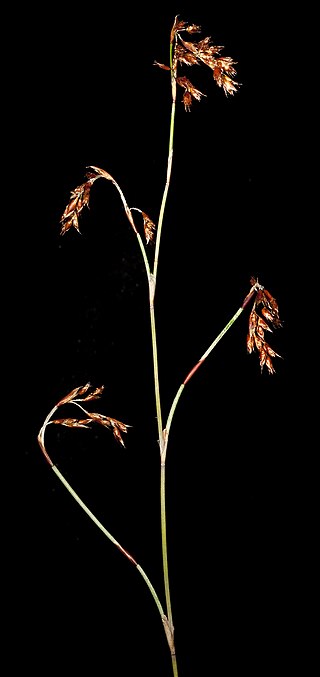
The Restionaceae, also called restiads and restios, are a family of flowering plants native to the Southern Hemisphere; they vary from a few centimeters to 3 meters in height. Following the APG IV (2016): the family now includes the former families Anarthriaceae, Centrolepidaceae and Lyginiaceae, and as such includes 51 genera with 572 known species. Based on evidence from fossil pollen, the Restionaceae likely originated more than 65 million years ago during the Late Cretaceous period, when the southern continents were still part of Gondwana.

Xylomelum is a genus of six species of flowering plants, often commonly known as woody pears, in the family Proteaceae and are endemic to Australia. Plants in this genus are tall shrubs or small trees with leaves arranged in opposite pairs, relatively small flowers arranged in spike-like groups, and the fruit a woody, more or less pear-shaped follicle.

Acidonia microcarpa is a species of shrub in the plant family Proteaceae. It is the only species in the genus Acidonia. It is endemic to the south coast of the Southwest Botanic Province of Western Australia.
Hypolaena is a plant genus in the family Restionaceae, described as a genus in 1810. The entire genus is endemic to Australia.

Centrolepis strigosa, commonly known as hairy centrolepis, is a species of plant of the Restionaceae family. It is found in New Zealand. and Australia

Baloskion tetraphyllum is a rush-like plant in the family Restionaceae. Common names include tassel rope-rush, plume rush and Australian reed.
Hollandaea is a small genus of plants in the family Proteaceae containing four species of Australian rainforest trees. All four species are endemic to restricted areas of the Wet Tropics of northeast Queensland.

Meeboldina is a plant genus in the family Restionaceae, described as a genus in 1943. It is named for the botanical collector Alfred Meebold.
Cyperus latzii is a sedge of the family Cyperaceae that is native to Australia, and found in the Northern Territory and Western Australia.

Desmocladus is a genus of herbs in the family Restionaceae, all species of which are endemic to Australia, and found in Western Australia and South Australia. In this genus, the stems are the principal photosynthesizers.

Desmocladus flexuosus is a rhizatomous, sedge-like herb in the Restionaceae family, endemic to south-west Western Australia.

Chaetanthus aristatus is a species of rush. It is found in Western Australia.

Chordifex laxus is a rush species of the genus Chordifex in the family Restionaceae. It is endemic to the south-west of Western Australia.

Chordifex microdon is a rush species of the genus Chordifex in the family Restionaceae, native to Western Australia.
Leptocarpus laxus is a rush species of the genus Leptocarpus in the family Restionaceae. It is endemic to the south-west of Western Australia.

Tremulina is a genus of flowering plants belonging to the family Restionaceae. The genus was first described in 1998 by Barbara Briggs & Lawrie Johnson. The type species is Tremulina tremula.

Pterochaeta is a monotypic plant genus in the Asteraceae family, endemic to Western Australia. It was first described in 1845 by Joachim Steetz and its only species is Pterochaeta paniculata.

Tremulina tremula is a plant in the Restionaceae family, found in the south-west of Western Australia.

Leptocarpus coangustatus is a species of plant in the Restionaceae (rush) family, endemic to Western Australia.

Leptocarpus denmarkicus is a species of plant in the Restionaceae (rush) family, endemic to Western Australia.














